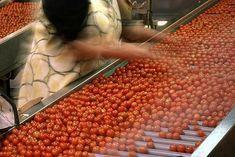
Cherry and plum growers in the Extremadura region of Spain, to the west of Madrid, are counting the cost of hail storms, after looking forward to the prospect of bumper crops.
However the later maturing Picota variety, which can be harvested leaving the stalk on the tree, appears to have fared better than traditional varieties. It has been granted unique denomination status by the EU and can trace its history back to the 14th century.
Today it is still grown in small plots on the steep sided river valleys by some 4,000 families accounting for around 10,000 hectares. Trees are topped regularly to facilitate picking.
While these orchards provide a potential of some 8,000 tonnes, production seldom reaches these levels, although a strong export market has been built up in the UK attracting Morrisons, Asda, Somerfield and Iceland. Once again this year the industry has launched a promotional campaign through Foods from Spain between June and August. It has a £250,000 budget.
However there is now increasing interest in widening the season selecting conventional varieties chosen from Canada, Chile, Poland, France and Italy.
Varieties like Van, Summit, and Sunburst, followed by Sweetheart and Lapins are already commercial adding another month to the calendar, according to Marcos Manzano, technical director. Others in the pipeline showing promise are with Marmotte, Burlat and Starking.
While Picotas thrive on higher ground, fruit ripens later and orchards take 10 years to mature and have to be constantly topped. "We can plant the new varieties and expect commercial yields in four years," he adds.
Part of the work however is to find other rootstocks for Picotas to grow smaller trees as a way to reduce the labour cost of harvesting.
Further south near Badajoz, the region has become the largest single plum production area in Europe within 25 years, said Miguel Angel Gomez, managing director of Afruex, the grower/exporters association.
The region has seen its stone fruit orchards blossom to reach 13,000 hectares plums, nectarines and peaches, with an anticipated growth of a further 15 percent ahead.
The key has been water availability which in the rest of Spain is becoming increasingly expensive, a fact which originally encouraged growers in established areas such as Murcia to invest with locals dependent on rice and tomatoes to follow suite.
Major varieties at present are black skimmed US/Japanese strains with red and yellow flesh, such as Larry Anne, Fortune, and Angelino, although when accounting for Red Beaut, Pioneer, Black Beaut, Amber, Star, Prime Time and Villa Rosa, the combination allows the season to begin in May with harvesting lasting through until August.
But according to Gomez: "Varieties chosen by retailers are changing too fast for growers to adapt. Already Sungold, for example, is being dropped as it does not ripen to the levels of colour they specify."
Possibilities which currently lie ahead include a range of hybrid pluots, and flattened donut shaped peaches and plums.



